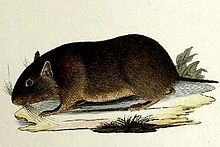
The collared tuco-tuco is a tuco-tuco species from South America. It is found in southern Brazil, Uruguay and northern Argentina where it lives underground in a burrow it digs in savannah habitats. It is a relatively common species and the IUCN has assessed its conservation status as being of "least concern".
Ruschi's rat or Ruschi's spiny mouse is a rodent species found in Argentina and Brazil. Some cranial features suggest it may be an archaic relative of the paramo Oldfield mouse. The upper parts are greyish yellow with a darker head and yellowish-white underparts. Fine hairs are mixed with flattened and grooved spines that are most numerous on the back.

Euryoryzomys nitidus, also known as the elegant oryzomys or elegant rice rat, is a rodent species in the family Cricetidae. Previously it was known as Oryzomys nitidus, but it is not closely related to Oryzomys as that genus is now constructed. Its range includes Bolivia, Brazil and Peru to the east of the Andes, in lowland tropical rainforest as well as forest in the eastern foothills of the mountains, at elevations from 50 to 2,000 m.

Abrothrix longipilis, also known as the long-haired grass mouse or long-haired akodont, is a species of rodent in the family Cricetidae. It is found in central and southern Argentina and Chile. The southern Chilean Abrothrix sanborni may not be distinct from this species.
Abrothrix olivacea, also known as the olive grass mouse or olive akodont, is a species of rodent in the genus Abrothrix of family Cricetidae. It is found from northern Chile into southern Chile and Argentina, including the islands of Tierra del Fuego. It is prone to large swings in population size.

Oligoryzomys longicaudatus, also known as the long-tailed colilargo or long-tailed pygmy rice rat, is a species of rodent in the genus Oligoryzomys of the family Cricetidae. It is found in the southern Andes of Chile and Argentina, with an outlying population in eastern Argentina. As a common species with a wide range and a stable population, the International Union for Conservation of Nature has rated this rodent as being of "least concern".
Oligoryzomys magellanicus, also known as the Patagonian colilargo and the Magellanic pygmy rice rat, is a species of rodent in the genus Oligoryzomys of the family Cricetidae. It is found in the southernmost parts of Argentina and Chile, including Tierra del Fuego and other outlying islands. Its karyotype has 2n = 54 and FNa = 66.

Bennett's chinchilla rat is a species of chinchilla rat in the family Abrocomidae. It is found only in Chile where its habitat is Mediterranean-type scrub on the western side of the Andes. The IUCN has assessed its conservation status as being of "least concern".
Sage's rock rat is a species of rodent in the family Octodontidae. It is found in Argentina and possibly Chile.

Emily's tuco-tuco is a species of rodent in the family Ctenomyidae. It is endemic to Argentina.
The tawny tuco-tuco is a species of burrowing rodent in the family Ctenomyidae. It is found in the desert regions of northern Chile and adjoining areas of Argentina.
The Maule tuco-tuco is a species of rodent in the family Ctenomyidae. It is found in Argentina and Chile where it occupies several different types of habitats. It is a common species and the IUCN has assessed its conservation status as being of "least concern". The common and scientific names refer to a river and region in Chile within its range.
The Mendoza tuco-tuco is a species of rodent in the family Ctenomyidae.
The highland tuco-tuco is a species of rodent in the family Ctenomyidae. It is found in high grassland in Argentina, Bolivia, Chile, and Peru where it lives in burrows.
The robust tuco-tuco is a species of rodent in the family Ctenomyidae. It is a burrowing rodent and is endemic to the Tucumán Province of Argentina.

The mountain degu is a species of rodent in the family Octodontidae. It is the only species in the genus Octodontomys. It is found in the foothills of the Andes in Argentina, Bolivia and Chile.
Porter's rock rat is a species of rodent in the family Octodontidae. It is found in Argentina and Chile at altitudes between 900 and 2,000 meters above sea level.

Octodontidae is a family of rodents, restricted to southwestern South America. Fourteen species of octodontid are recognised, arranged in seven genera. The best known species is the common degu, Octodon degus.
The Puntilla tuco-tuco is a species of rodent in the family Ctenomyidae. It is endemic to central Argentina. The common name of the species comes from the municipality of La Puntilla at the type locality. It was first described by the British zoologist Oldfield Thomas in 1920 after being collected by Emilio Budin, an Argentine specimen collector who worked with Oldfield Thomas.









